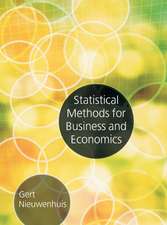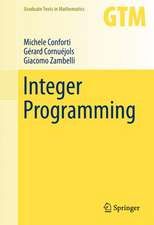Engineering Risk and Finance: International Series in Operations Research & Management Science, cartea 188
Autor Charles S. Tapieroen Limba Engleză Hardback – 14 feb 2013
This book provides a broad and interdisciplinary foundation to engineering risks and to their financial valuation and pricing. Risk models applied in industry and business, heath care, safety, the environment and regulation are used to highlight their variety while financial valuation techniques are used to assess their financial consequences.
This book is technically accessible to all readers and students with a basic background in probability and statistics (with 3 chapters devoted to introduce their elements). Principles of risk measurement, valuation and financial pricing as well as the economics of uncertainty are outlined in 5 chapters with numerous examples and applications. New results, extending classical models such as the CCAPM are presented providing insights to assess the risks and their price in an interconnected, dependent and strategic economic environment. In an environment departing from the fundamental assumptions we make regarding financial markets, the book provides a strategic/game-like approach to assess the risk and the opportunities that such an environment implies. To control these risks, a strategic-control approach is developed that recognizes that many risks resultingby “what we do” as well as “what others do”. In particular we address the strategic and statistical control of compliance in large financial institutions confronted increasingly with a complex and far more extensive regulation.
| Toate formatele și edițiile | Preț | Express |
|---|---|---|
| Paperback (1) | 955.40 lei 43-57 zile | |
| Springer Us – 8 feb 2015 | 955.40 lei 43-57 zile | |
| Hardback (1) | 961.72 lei 43-57 zile | |
| Springer Us – 14 feb 2013 | 961.72 lei 43-57 zile |
Din seria International Series in Operations Research & Management Science
- 20%
 Preț: 331.25 lei
Preț: 331.25 lei - 20%
 Preț: 570.61 lei
Preț: 570.61 lei - 18%
 Preț: 1132.02 lei
Preț: 1132.02 lei - 18%
 Preț: 773.72 lei
Preț: 773.72 lei -
 Preț: 170.39 lei
Preț: 170.39 lei - 17%
 Preț: 459.34 lei
Preț: 459.34 lei - 17%
 Preț: 360.47 lei
Preț: 360.47 lei -
 Preț: 263.40 lei
Preț: 263.40 lei - 24%
 Preț: 905.30 lei
Preț: 905.30 lei - 17%
 Preț: 460.08 lei
Preț: 460.08 lei - 17%
 Preț: 459.34 lei
Preț: 459.34 lei - 20%
 Preț: 631.58 lei
Preț: 631.58 lei - 13%
 Preț: 448.62 lei
Preț: 448.62 lei - 18%
 Preț: 738.28 lei
Preț: 738.28 lei - 18%
 Preț: 1225.94 lei
Preț: 1225.94 lei - 18%
 Preț: 948.92 lei
Preț: 948.92 lei - 18%
 Preț: 703.88 lei
Preț: 703.88 lei - 18%
 Preț: 957.44 lei
Preț: 957.44 lei - 15%
 Preț: 651.84 lei
Preț: 651.84 lei - 20%
 Preț: 336.21 lei
Preț: 336.21 lei - 15%
 Preț: 641.03 lei
Preț: 641.03 lei -
 Preț: 404.29 lei
Preț: 404.29 lei - 18%
 Preț: 950.21 lei
Preț: 950.21 lei - 15%
 Preț: 649.06 lei
Preț: 649.06 lei - 18%
 Preț: 725.75 lei
Preț: 725.75 lei -
 Preț: 394.12 lei
Preț: 394.12 lei - 18%
 Preț: 951.47 lei
Preț: 951.47 lei - 15%
 Preț: 639.59 lei
Preț: 639.59 lei - 18%
 Preț: 773.06 lei
Preț: 773.06 lei - 18%
 Preț: 889.29 lei
Preț: 889.29 lei - 15%
 Preț: 655.60 lei
Preț: 655.60 lei - 15%
 Preț: 640.06 lei
Preț: 640.06 lei - 15%
 Preț: 583.93 lei
Preț: 583.93 lei
Preț: 961.72 lei
Preț vechi: 1172.83 lei
-18% Nou
Puncte Express: 1443
Preț estimativ în valută:
184.03€ • 192.62$ • 153.17£
184.03€ • 192.62$ • 153.17£
Carte tipărită la comandă
Livrare economică 31 martie-14 aprilie
Preluare comenzi: 021 569.72.76
Specificații
ISBN-13: 9781461462330
ISBN-10: 1461462339
Pagini: 528
Ilustrații: XVIII, 508 p. 41 illus., 30 illus. in color.
Dimensiuni: 155 x 235 x 34 mm
Greutate: 0.91 kg
Ediția:2013
Editura: Springer Us
Colecția Springer
Seria International Series in Operations Research & Management Science
Locul publicării:New York, NY, United States
ISBN-10: 1461462339
Pagini: 528
Ilustrații: XVIII, 508 p. 41 illus., 30 illus. in color.
Dimensiuni: 155 x 235 x 34 mm
Greutate: 0.91 kg
Ediția:2013
Editura: Springer Us
Colecția Springer
Seria International Series in Operations Research & Management Science
Locul publicării:New York, NY, United States
Public țintă
ResearchCuprins
Risk: The Convergence.- Risk Management Everywhere.- Probability Elements: An Applied Refresher.- Multivariate Probability Distributions: Applications and Risk Models.- Temporal Risk Processes.- Risk Measurement.- Risk Valuation.- Risk Economics and the Extended CCAPM.- Risk Pricing Models: Applications.- Uncertainty Economics.- Strategic Risk Control and Regulation.- Games, Risk, and Uncertainty.
Recenzii
From the book reviews:
“This is an encyclopedic book on risk management in finance. Intended as a background text for undergraduate and graduate courses in risk finance and in risk engineering and management, yet unlike many textbooks, this book uses an interdisciplinary approach in the sense that it attempts to view risks as faced by many disciplines. As such, it can be used as a reference book for professionals and practitioners with diverse backgrounds.” (Youngna Choi, Mathematical Reviews, May, 2014)
“The book is recommended as an undergraduate and graduate text in risk finance, risk engineering and management, as well as for professionals that are both concerned and experienced in risk assessment and management techniques.” (George Stoica, zbMATH, Vol. 1272, 2013)
“This is an encyclopedic book on risk management in finance. Intended as a background text for undergraduate and graduate courses in risk finance and in risk engineering and management, yet unlike many textbooks, this book uses an interdisciplinary approach in the sense that it attempts to view risks as faced by many disciplines. As such, it can be used as a reference book for professionals and practitioners with diverse backgrounds.” (Youngna Choi, Mathematical Reviews, May, 2014)
“The book is recommended as an undergraduate and graduate text in risk finance, risk engineering and management, as well as for professionals that are both concerned and experienced in risk assessment and management techniques.” (George Stoica, zbMATH, Vol. 1272, 2013)
Textul de pe ultima copertă
Risk models are models of uncertainty, engineered for some purposes. They are “educated guesses and hypotheses” assessed and valued in terms of well-defined future states and their consequences. They are engineered to predict, to manage countable and accountable futures and to provide a frame of reference within which we may believe that “uncertainty is tamed.” Quantitative-statistical tools are used to reconcile our information, experience and other knowledge with hypotheses that both serve as the foundation of risk models and also value and price risk. Risk models are therefore common to most professions, each with its own methods and techniques based on their needs, experience and a wisdom accrued over long periods of time.
This book provides a broad and interdisciplinary foundation to engineering risks and to their financial valuation and pricing. Risk models applied in industry and business, heath care, safety, the environment and regulation are used to highlight their variety while financial valuation techniques are used to assess their financial consequences.
This book is technically accessible to all readers and students with a basic background in probability and statistics (with 3 chapters devoted to introduce their elements). Principles of risk measurement, valuation and financial pricing as well as the economics of uncertainty are outlined in 5 chapters with numerous examples and applications. New results, extending classical models such as the CCAPM are presented providing insights to assess the risks and their price in an interconnected, dependent and strategic economic environment. In an environment departing from the fundamental assumptions we make regarding financial markets, the book provides a strategic/game-like approach to assess the risk and the opportunities that such an environment implies. To control these risks, a strategic-control approach is developed that recognizes that many risks result by “what wedo” as well as “what others do”. In particular we address the strategic and statistical control of compliance in large financial institutions confronted increasingly with a complex and far more extensive regulation.
This book provides a broad and interdisciplinary foundation to engineering risks and to their financial valuation and pricing. Risk models applied in industry and business, heath care, safety, the environment and regulation are used to highlight their variety while financial valuation techniques are used to assess their financial consequences.
This book is technically accessible to all readers and students with a basic background in probability and statistics (with 3 chapters devoted to introduce their elements). Principles of risk measurement, valuation and financial pricing as well as the economics of uncertainty are outlined in 5 chapters with numerous examples and applications. New results, extending classical models such as the CCAPM are presented providing insights to assess the risks and their price in an interconnected, dependent and strategic economic environment. In an environment departing from the fundamental assumptions we make regarding financial markets, the book provides a strategic/game-like approach to assess the risk and the opportunities that such an environment implies. To control these risks, a strategic-control approach is developed that recognizes that many risks result by “what wedo” as well as “what others do”. In particular we address the strategic and statistical control of compliance in large financial institutions confronted increasingly with a complex and far more extensive regulation.
Caracteristici
Focus on developing an interdisciplinary approach that unifies the methodology and terminology of risk so it can be applied in virtually any context Uses both a narrative (for non quantitative readers) and mathematical techniques (with basic introduction to these techniques in mathematical appendices), making the book accessible Charles S. Tapiero is an internationally renowned researcher and consultant who has both the breadth and depth of knowledge in this area? Includes supplementary material: sn.pub/extras












